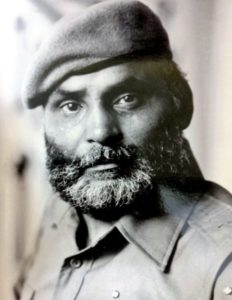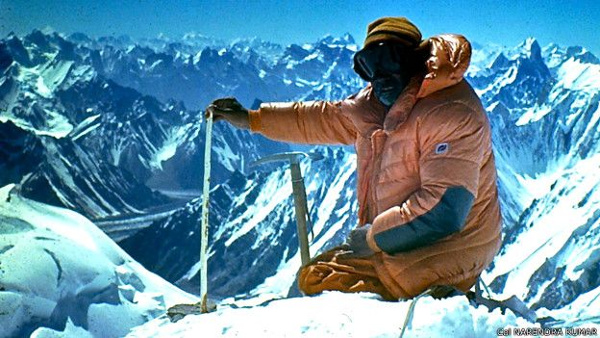In the world of the Indian Armed Forces, he is known as ‘Bull’ Kumar. Colonel Narendra Kumar earned this unusual moniker when he charged at his six inch taller and tougher rival during his first boxing match at the National Defence Academy. His opponent and senior, Sunith Francis Rodrigues, went on to win the match and later become the Chief of Army Staff.

Col. Kumar, on the other hand, lost the bout but the nickname stuck. And he has more than lived up to it. Like a bull in a rodeo, the short and stocky army man loves a challenges and goes at it with a relentless single-minded focus, irrespective of its ramifications.
These qualities is perhaps why Col. Kumar almost single-handedly ensured India’s presence at Siachen in 1981, that too without spilling the blood of any soldier in the snowy realm.
Here’s the untold story of how how he accomplished this extraordinary feat
It all started with a German mountaineer and an American map. In the late 1970s, Col.Kumar was in charge of the High Altitude Warfare School in Gulmarg (which was also the mountain warfare school of the Indian Army).
A German explorer — with whom Kumar had earlier traversed the upper reaches of the Indus river in Ladakh — showed him an American map of northern Kashmir that marked the Line of Control (LoC) much further to the east than he expected.
Realising that the US appeared to have cartographically ceded a large chunk of eastern Karakoram (including the Siachen glacier) to Pakistan, a furious Col. Kumar bought the map and sent it straight to the Director General of Military Operations.
Alarm bells ringing loudly in his head, he also volunteered to organise an expedition to the area to “correct the map”. Realising the need to cut through red tape and get to work, the recon mission was thus termed a ‘practical training session’ for students.
Soon after, Col. Kumar headed into uncharted territory with a team of students from the High Altitude Warfare School. It was the first Indian expedition into the heart of Siachen — the largest alpine glacier on earth that has nearly two trillion cubic feet of ice.
Beginning at the snout of the glacier, Col. Kumar and his team slowly but steadily made their way up the massive bulk of unforgiving ice. On the way, they had to navigate tricky crevasses and stay ahead of avalanches while braving temperatures that dipped to a numbing -50 degrees Celsius.
Siachen (Representative Image)
What should be noted here is that these incredibly brave men did all this without any maps or hi-tech equipment. All they had was a rough idea of the ridges and peaks that had been named by the British decades ago.
However, news of this expedition soon leaked across the border. By the time Col. Kumar’s unarmed team reached the icy source of Siachen, Pakistani fighter jets had started flying over them, firing coloured smoke!
This and the trash that the team had found along the way — Pakistani cigarette packs, food cans and climbing gear — convinced him that the Pakistanis had been stealthily trying to entrench their claim on Siachen. Taking this trash and photos of the hovering jets as proof of Pakistani incursions, the team returned to base.
Despite this recon report, it took Col. Kumar a while to convince his seniors about the seriousness of situation. It was not until early 1981 that he finally got the go-ahead to map the entire glacier, all the way from the snout to the Chinese border.
And so Col. Kumar returned to Siachen, this time becoming the first Indian to climb the Sia Kangri —at 24,350 feet, this peak offers stunning views of the sprawling glacier. He came back with a detailed ‘sit-rep’ (situational report) that was immediately dispatched to Indian Army’s headquarters.
The next year, he wrote about his exploration of Siachen in the popular magazine The Illustrated Weekly of India, in effect staking India’s claim. Realising that the Indian Army was now clearly involved, Pakistan ramped up its stealthy bid to secure Siachen for itself.
It might have succeeded (in creating a formidable Pak-China corridor controlling the Karakoram Pass and threatening Ladakh) if the Indian intelligence had not learned of some interesting purchases made by Pakistani Army in London in 1984 — bulk orders of specialized mountain clothing.
Recognizing the strategic threat, India immediately dispatched troops of Kumaon Regiment to the Siachen for control of the glacier and the neighbouring peaks in the Saltoro range. Under Operation Meghdoot, IAF choppers pushed themselves to their maximum capabilities to air-drop soldiers at Bilafond-La (that translates to “Pass of the Butterflies” in Balti language).
And this is how India established a crucial military foothold in what would go on to become the world’s highest battlefield, beating Pakistan by a week. Their most important weapon? The detailed maps, photographs and videos made by Col. Kumar and his team.
In the years that followed, a key army post on the glacier was named Kumar Base, making Col. Kumar perhaps the only living Indian army officer to enjoy this extremely rare honour.
Incredibly, securing Siachen for India is just one (though extremely important) notch in Col. Kumar’s towering list of achievements.
The soldier-mountaineer (who lost four of his toes to frostbite in 1961) is the first to scale Nandadevi (1964), the first to put India on Everest (1965) and first to climb Kanchenjunga from its toughest north-east face (1976) — a mountaineering feat described by The British Alpine Journal as ‘far more difficult than the Everest ascent’.
A life-long friend of Tenzing Norgay, Col. Kumar has also entered the oxygen-depleted death zone above 8,000 m more than twenty times. In fact, every time he did this, the feisty soldier had to sign a non-liability certificate (because of his disability) saying that he absolve the government of all responsibilities should anything happen to him!
Unsurprisingly, this mountaineering legend is one of the most highly decorated officers in India. Narendra ‘Bull’ Kumar is the only colonel awarded the Param Vishisht Seva Medal (PVSM) distinction in all three services (normally accorded only to generals). He has also been honoured with the Padma Shri, the Kirti Chakra, the Ati Vishist Seva Medal, the Arjuna Award and the IMF Gold Medal by the Indian Mountaineering Foundation.
Furthermore, Col. Kumar is a winner of the McGregor Medal, awarded by the United Service Institution of India for the best military reconnaissance, exploration or survey in remote areas in the country. With this, he joined the illlustrious ranks of Sir Francis Younghusband (who explored the northern crown of Central Asia and India) and Major General Wingate (who conducted guerrilla recon missions deep in Burma).
Yet, few people in Indian know about Col. Kumar’s pioneering contributions to both mountaineering and national security. Its time we give him the respect and recognition he truly deserves.
Source:TBI
Imae Courtesy:Bullkumar.com
You may also like
-
Legendary Singer Lata Mangeshkar Passes Away At the Age of 92
-
Netaji’s Hologram Statue at India Gate
-
India’s First Woman Psychiatrist, Sarada Menon, Passes Away at 98
-
PM Inaugurates Adi Shankaracharya Samadhi and Unveils the Statue of Adi Shankaracharya
-
Government Announces 23rd January to be Celebrated as ‘PARAKRAM DIWAS’ Every Year
